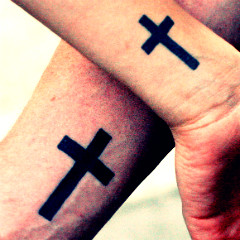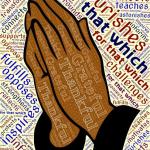I used to want a tattoo. That was more than twenty years ago, back in high school when only the brave and cool and rebellious people got tattoos.
Back then a neck tat meant you were hardcore. Today it means you’re a 19-year-old sorority girl.
I never did get the tattoo. I couldn’t make up my mind what I wanted to permanently etch on my epidermal canvas. Or what part of the canvas I would use. Something public? Or something I could cover up so my boss didn’t think I was secretly the chief of a biker gang?
Decisions, decisions.
But hesitation has paid me no regrets in this case.
My friend Matt got a wicked skeletal fairy inked on his back, between two massive wizard’s eyes on either shoulder blade. It was awesome. And then creepy. After years of wishing he’d done something else with his time, he had it re-inked. Now, thanks to the amazing work of a very talented needle man, the fairy and eyes are hidden behind and within a tree emblazoned with scripture.
The religious element makes sense. Long before they were used to display romantic attachment and late-adolescent boredom, tattoos were employed to indicate tribal affiliation and religious devotion.
Among Christians the acceptance of tattoos has always been mixed. The Mosaic law offers a line against them, and the fourth-century bishop, Basil the Great, apparently forbade tattoos. He was more successful in other endeavors, as Christians continued to decorate their bodies through the centuries.
Religious tattoos can take on a powerful meaning. In Flannery O’Connor’s story, “Parker’s Back,” she used a tattoo of Christ to show reprobate O.E. Parker’s newfound faith and expose his pious wife’s hypocrisy. Getting the tattoo was, in some sense, a saving act for Parker, a sacramental act. Then, in a shocking moment of violence, Parker’s wife, Sarah Ruth, beats his back with a broom, bruising Jesus.
Today it seems there are a lot more Parkers in church than Sarah Ruths. In some churches a tat is practically part of the pastoral uniform. Who needs a clerical collar when you have a full sleeve of crosses, doves, and broken, flaming hearts? Or maybe even Saul on the Damascus Road, as worship leader Carlos Whittaker sports on his arm?
Whittaker uses the tattoo as testimony and reminder. “I’ve had a big life change and momentum shift in my life,” he said on L.A. Ink, “and I want to remember that moment.”
The Christian rock band, the 77s, had an unconventional love song called “Tattoo” with obvious religious meaning:
If you say I’m written on your soul
then write me on your skin
Tattoos are the most personal kind of art. They capture our stories, confess our interests, and even identify our allegiances.
Coptic Christians have long tattooed their wrists with small crosses, little blue-green marks that silently profess their faith. It’s not without irony that the word witness in Greek is martyr. Copts are often harassed by Muslim neighbors for their markings, and reports of Christian girls forced into Muslim marriages include references to having their crosses cut out or burnt off with acid.
I don’t have strong feelings about tattoos one way or another. I’ve seen enough old men with blurry smudges that looked amazing four decades prior to have lost most interest in getting one. But maybe once the hipsters and sorority girls tire of them and they slip out of fashion, as they inevitably will, I’ll reconsider.
If you could get any tattoo what would it be? If you have some ink already, what’s your favorite? Comment below.
Side note: The official Orthodox position?
Here’s an article on the subject that might be of interest. It’s a piece from the Orthodox perspective by a priest out of Lansing, Mich. And on a side side note, it turns out that there is a tradition of Christian tattoos among Croats too, though I don’t know much at all about it.

















